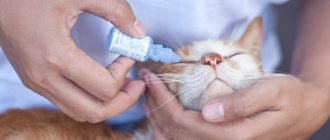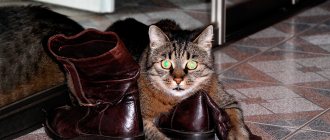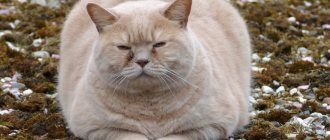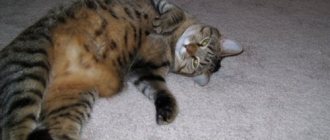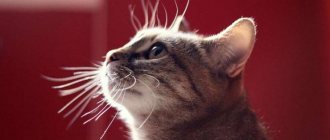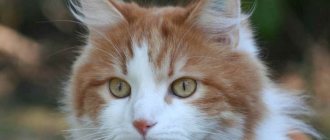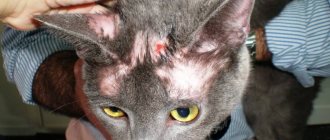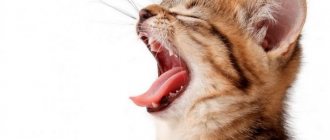The process of peeling off the top layer of keratinized skin occurs constantly, due to the renewal of the epidermis. Excessive accumulation of “scales” on the skin of an animal is called dandruff. Dandruff is a symptom of a pathological condition caused by disruption of the sebaceous glands and characterized by an increase in the rate of detachment of skin particles in the form of scales over a long period of time. The scientific name of this disease is seborrhea. It affects kittens and adult cats of all breeds, regardless of gender.
In the article we will tell you why dandruff appears, what to do when it is detected, how to cure seborrhea by going to the doctor and at home, as well as possible complications of the disease and preventive measures.
Main features
Signs of seborrhea in a cat:
- excessively oily skin under the coat;
- excessive amount of white “scales” of keratinized skin;
- inflammation (redness) of the skin;
- presence of itching.
There are three types of seborrhea:
- dry: “scales” of skin fall off when stroking the fur;
- oily: dandruff does not fall off when combed, the “scales” are glued together;
- mixed type.
Causes of dandruff
There are external and internal causes of the disease.
External ones include:
- Low level of air humidity. Dry air negatively affects the skin of the animal, the skin becomes thick and dry, and dandruff appears. Often accompanied by the appearance of cracks on the paw pads.
- Lack of proper care for the cat's fur and its place of residence, unsanitary conditions. In this regard, fleas, lice and other parasites appear and actively reproduce, causing irritation and itching of the skin. Dandruff can be caused by mites if the animal walks outside.
- The effects of cosmetics and cleaning products on animal fur.
Important! Using shampoo intended for humans may cause allergic reactions on your pet's skin.
- Improper combing of fur. Leads to irritation, scratches and microtraumas of the animal’s skin, which leads to accelerated skin regeneration and the appearance of “scales”.
- Sunburn or excess ultraviolet rays. They lead to accelerated death of epidermal cells and, accordingly, the appearance of dandruff.
- Stressful situations. For example: sterilization, moving to a new place, bringing another pet or child into the house.
- Frequent contact with water. Constant wetting of the skin causes irritation and drying out of the upper layer of the epidermis.
Internal factors:
- Incorrectly formulated diet. It entails a lot of health problems, such as:
- Obesity. If an animal is overweight, it is difficult to care for itself, reaching the back and lumbar area, which is why excess dandruff accumulates in these places.
- Allergic reactions.
Carefully! Allergies can be caused not only by food, but also by chemicals in finished food.
- Problems with the digestive system. They lead to metabolic disorders in the body, which affects the appearance of the cat.
- Vitamin deficiency or excess vitamins. For example, when there is a lack of vitamins A and B in the body, or when there is an excess of them, seborrhea appears.
- Bacterial or fungal diseases. For example, microsporia or lichen lead to skin irritation, constant itching and hair loss in the affected areas.
- Hormonal disorders (hypothyroidism, sex hormone imbalance, Cushing's syndrome). Disturbed metabolism associated with the functioning of the thyroid gland leads to seborrhea.
- Diseases of the musculoskeletal system (arthritis, arthrosis). Pain in the joints when moving prevents the cat from grooming the rump and tail areas, which leads to excessive deposits of “scales” on the skin in these areas.
- Diabetes. A disease associated with insufficient production of the hormone insulin and leading to metabolic disorders, which also affects the animal’s skin.
- Diseases of the urinary system.
- Seborrhea of idiopathic form. This is a hereditary disease characterized by the active secretion of sebum.
- Side effect from drug treatment. Skin reactions occur to medicated shampoo or to taking medications.
In what cases does the presence of dandruff indicate a disease?
In most cases, dandruff is a consequence of secondary seborrhea and a symptom of another disease, possibly occurring hidden:
- endocrine disorders, often occurs with pathology of the thyroid gland or dysfunction of the reproductive glands;
- allergic conditions, allergens can be food ingredients, cat care products and other factors;
- fungal skin infections, often caused by ringworm;
- obesity, in which the cat cannot fully groom its fur, especially on the back and lower back, because it becomes clumsy and cannot reach;
- joint diseases, which also prevent the cat from self-grooming due to joint pain that limits the cat’s mobility, while the rump, tail and back are covered with dandruff;
- the presence of skin parasites, fleas and ticks that irritate the cat’s skin and can also cause allergies to the components of their saliva and secretions;
- diseases of the digestive system, which result in metabolic disorders, especially the liver and pancreas;
- chronic viral diseases, for example, feline viral leukemia;
- unbalanced diet, with deficiency of: vitamins, especially A and group B;
- polyunsaturated fatty acids;
- minerals and trace elements;
In some cases, seborrhea may indicate improper cat care, for example, frequent bathing or the use of inappropriate pet shampoo, which dries out the cat's skin.
When dandruff appears, the owner's attention may be drawn to the following signs:
- a change in the cat’s odor due to the presence of secondary infection with fungal and bacterial flora; the smell is musty or moldy in nature, and its intensity depends on the severity of microbial or fungal contamination;
- the cat’s anxiety or resistance when feeling certain areas of the body; if you part the fur, you can see dry or, conversely, oily skin with signs of redness and irritation, and if you pay attention to the skin folds on the cat’s stomach and paws, you can see signs of acute or chronic inflammation skin - dermatitis.
To treat dandruff, antiseborrheic shampoos are used to regulate the activity of the sebaceous glands.
When to contact a veterinarian
A veterinarian should be contacted in all cases of dandruff to determine its cause, since dandruff is often a symptom of a general disease, including a contagious one, such as ringworm, which is transmitted to both people and other animals.
The veterinarian examines the cat, interviews the owner and conducts additional diagnostic tests:
- general blood analysis;
- blood chemistry;
- blood test for hormone levels;
- carrying out skin scrapings with their subsequent microscopy;
- bacteriological research - carrying out sowing of flora on a culture medium to identify the pathogen, most often used to isolate the causative agent of ringworm in the latent form of the disease;
- sometimes a biopsy of the affected areas of the skin is performed to clarify the nature of the inflammation.
Consultation with a veterinarian is necessary if dandruff is detected in your pet.
Use of veterinary drugs and medicinal shampoos
Since dandruff is caused by various reasons, it is treated with different therapeutic agents.
In cases where dandruff is caused by secondary seborrhea, the leading role belongs to the treatment of the underlying disease, otherwise, after a short-term improvement after using zoo shampoos, dandruff will return.
The following are used in the treatment of dandruff:
- antiseborrheic shampoos that regulate sebum production: Anti-Dandruff from Beaphar;
- shampoo Doctor;
- Cytoderm shampoo;
- Tropiclean dry shampoo;
- other means;
- Frontline spot it;
- isotretinoin;
- Sinulox - for bacterial flora;
- Omega-3 Pet;
Due to the content of polyunsaturated fatty acids, fish oil preparations improve the condition of the skin with dry seborrhea
Table: overview of products for treating dandruff in cats
| A drug | Compound | Operating principle | Price, rub |
| Shampoo Doctor | Benzoyl peroxide, sodium lauryl sulfate, coconut oil | Removes exfoliated epidermis, skin secretions, normalizes the activity of the sebaceous glands, has anti-inflammatory and antipruritic effects; deodorizes wool; after using shampoo, the effectiveness of external antibacterial and antiparasitic drugs increases; reduces the amount of pathogenic microflora present on the skin. Used for treatment every day or at intervals of 1–3 days; if skin peeling increases, apply once every 5–7 days | 265 |
| Shampoo Cytoderm | Climbazole, zinc pyrithione, aloe vera extract, malic acid | Eliminates dandruff and prevents its reoccurrence; eliminates dryness and irritation of the skin. Climbazole has an antifungal effect; Zinc pyrithione regulates the activity of the sebaceous glands and exhibits an anti-inflammatory effect; aloe vera has a softening, soothing effect, relieves irritation; malic acid gently exfoliates the top layer of skin, stimulating its renewal | from 361 |
| Shampoo Tropiclean | Mild organic cleanser based on coconut oil; protein hydrolyzate, cucumber extract, oatmeal | Dry shampoo for cats that don't want to wash themselves; Can be used between baths. Eliminates dirt and gland secretions from the skin and coat, as well as irritation and flaking. Has a nourishing and moisturizing effect. Eliminates unpleasant odors | 700 |
| Frontline Spot on | Fipronil | Insectoacaricide, eliminates fleas, lice-eaters, cheyletiella, lice, ticks, including the causative agent of otodecosis | 335 per pipette |
| Retinoic ointment | Isotretinoin | Eliminates excess sebum production; normalizes regenerative processes in the skin. Not for pregnant women - causes deformities in the fetus even when applied topically | from 230 |
| Sinulox | Amoxicillin, clavulanic acid | Broad-spectrum antibacterial agent. Not allowed during pregnancy | from 192 (tablets 50 mg No. 10) |
| Itraconazole | Itraconazole | Antifungal drug. Not allowed during pregnancy | from 219 |
| Nordic Naturals Omega-3 Pet | Wild anchovy and sardine fat | A food supplement containing polyunsaturated fatty acids necessary for the normal functioning of the skin, joints, and heart; improve coat. Used for dry seborrhea | 2150 |
Use of traditional medicine
Drug therapy for dandruff can be supplemented with the use of traditional medicine:
- To rinse cats, they use infusions of herbs: burdock - healing and antipruritic, has a calming effect;
- calendula - has antiseptic and healing properties;
- nettle - regulates the activity of the sebaceous glands, promotes healing, increases skin elasticity;
- coltsfoot - anti-inflammatory effect, cleanses skin pores, regulates the activity of the sebaceous glands;
- calamus root (must be grated) - anti-inflammatory, wound healing agent.
- Pour 100 g of dry or 600 g of fresh raw materials with 2 liters of water.
Rinsing with coltsfoot infusion helps normalize sebum secretion and eliminate dandruff.
Types of dandruff
Dandruff is distinguished by color and location:
- By color:
- Yellow-white (grains or flakes) is localized on the back and other areas due to allergies, sunburn or malfunction of internal organs.
Black impurities in dandruff
- Black flecks in the fur along with dandruff can be a sign of fungal infections or the presence of parasites.
- By localization:
- On the back, in the area of the tail and lower back, symptoms of seborrhea most often appear due to fungal diseases (for example, microsporia, dermatomycosis), worms, sunburn, or due to the animal being overweight. Diseases of the musculoskeletal system can also affect this, preventing the cat from fully carrying out independent hygiene procedures.
- The “wandering” nature of seborrhea indicates the presence of parasites in the body, for example, subcutaneous mites. It may also be accompanied by baldness in certain areas of the skin, which is one of the symptoms of lichen or adenitis.
Why is dandruff dangerous for cats?
Cat dandruff is a favorable environment for the development of pathogens. Bacteria live on the body of healthy animals, but due to their strong immune defense they do not cause harm. The keratinized particles of the epidermis weaken the immune system, causing redness and itchy irritation to appear on the body. Due to scratching, purulent ulcers form in these areas, turning into eczema.
If your pet has dandruff and hair loss, it means that gas exchange and skin metabolism have slowed down due to the accumulation of dead cells. This phenomenon can result in baldness. Complete destruction of hair follicles leads to the impossibility of hair restoration.
How to prevent seborrhea
Try to help your pet get rid of the disease yourself using the following methods:
- carry out antiparasitic treatment at home;
- check the air humidity level, you may need a humidifier;
Bathing a cat to treat dandruff
- examine the animal’s fur for the presence of fleas and ticks, if necessary, use a special shampoo or spray to get rid of them;
- study the composition of your cat’s diet for foods that can cause allergies or digestive problems;
- evaluate the appearance of the animal, it may be obese, and it is necessary to adjust the diet and diet;
- do not wash your pet more than once every 2 months; when washing, use only shampoo intended for this purpose and not too hot water;
- check the composition of household chemicals used when cleaning the house; you may have to change the products to less allergenic ones.
Important! If after carrying out all the above measures the disease progresses, contact your veterinarian.
Prepare in advance the answers to the questions that the doctor will ask you at the appointment to make the correct diagnosis. List of sample questions:
- What is the cat’s diet (main products, diet, amount of food).
- Basic habits and behavioral characteristics of the pet (for example, does it like to lie in the sun, which can cause sunburn).
- How well are hygiene rules observed at home?
- What products and how often do you use when bathing your pet and cleaning the house?
- What vitamin supplements do you give?
- Where and in what conditions does the cat live?
- What was or is you sick with? What medications were used for treatment.
- How do you care for your fur?
After collecting anamnesis, the doctor will prescribe the following tests:
- general blood test and biochemistry;
- blood test for hormones;
- skin scraping;
- inoculation on a nutrient medium and identification of skin culture;
- skin biopsy.
Folk remedies
You can get rid of dandruff using home remedies. First, determine what kind of dandruff is dry, oily or mixed.
- Dry - easily shakes off cat hair and your hands. With it, the wool takes on a dull appearance;
Lactic acid, oils and urea will help with dry dandruff - use them when bathing your cat.
- Oily – characterized by greasiness that remains on your hands; the hairs themselves stick together.
For oily dandruff, products with a drying effect will help - vinegar, products containing sulfur, salicylic acid. Rubbing olive and burdock oils into the skin and coat will have a beneficial effect.
Every other day, wipe the fur with a decoction of medicinal herbs - burdock, string, calendula, oats. Once a month, bathe your cat in a herbal decoction or rinse its fur after shampooing.
Treatment of seborrhea
Treatment of seborrhea is prescribed comprehensively, it includes:
- prescription of medications;
- changing the diet and composition of food;
- prescription of vitamins (Sherstevit, Phytomins VEDA, Farmavit NEO, Beaphar and others) and food additives containing Omega-3 fatty acids;
- prescribing a course of antifungal therapy and antibiotics for fungal and bacterial infections, as well as retinoids;
- improving the sanitary condition of the room where the cat lives;
- changing the care of the animal's fur;
- use of medicated shampoos;
- use of folk remedies;
- skin massage and proper combing of the coat.
Carefully! At home, treatment of seborrhea can be carried out after consulting a doctor, prescribing special detergents and permission to use traditional medicine.
Effective shampoos for seborrhea include:
- Antifungal and antiseborrheic: “Doctor”, “Veterinary Formula Clinical Care”, “Tea Tree”, SynergyLabs Veterinary Formula Antiseptic & Antifungal, Anju Beauté.
- For fleas and parasites: “Clandestine”, “Bayer Adventage 80”, “Beaphar”, “Fiprex”.
- For ectoparasites: "Lufenuron Oral Suspension For Cats".
- To normalize the functioning of the sebaceous glands: “Biovax”
Such shampoos, in a certain dosage, contain substances that can fight the disease and its consequences, for example:
- chlorhexine (antibacterial effect);
- zinc (skin regeneration and healing);
- salicylic acid (exfoliation of dead epithelial cells, healing of the skin);
- vinegar (fights infections, has an antibacterial effect);
- olive, burdock or calendula oils (promote softening and renewal);
- herbs: string, chamomile, burdock (relieves itching, irritation, restores epithelium).
It is dangerous to practice many of these ingredients on your own to treat seborrhea without consulting your doctor; you need to know the correct dosage, frequency and duration of their use.
Treatment at home
There are traditional medicine remedies and recipes that your doctor will most likely allow you to use to fight the disease at home:
- Bathing the pet once every 2 months with a special shampoo, massaging the skin and combing the skin during the procedure. Actions during and after washing: for dry seborrhea, use moisturizers in the form of oils added to water (urea, propylene glycol, sodium lactate, lactic acid);
- in case of oily seborrhea, in case of severe course and complications of the disease with dermatitis, remove the hair from the pet’s skin, then use bandages with ethyl alcohol for disinfection, treat the skin with Engystol to eliminate inflammation and itching. In addition, for this type of disease, products are used that degrease and dry excessively oily skin (sulfur compounds 0.5-2%, salicylic acid 0.5-2%, selenium sulfide, benzoyl peroxide).
- series;
How to get rid of dandruff
If your cat has dandruff, it is important to prevent the physiological problem from becoming a pathological process. In addition to the unkempt appearance, the pet suffers from unbearable itching, so you need to quickly eliminate the discomfort.
Your veterinarian will tell you how to treat dandruff in a cat after examination and making a final diagnosis. In such a situation, a set of measures is required. Prescriptions depend on the cause that provoked seborrhea: elimination of inflammation, parasites, fungus, restoration of hormonal levels.
Drug therapy includes:
- Oral antimycotic or antiparasitic drugs: Ketoconazole, Griseofulvin, Fluconazole, Fenpraz, Alben.
- Local sprays that eliminate itching and peeling: YaM ointment or Sanoderm, Termicon or Exoderil cream, Fungin spray, Clotrimazole.
- Multivitamin complexes: Farmax, Beaphar, Polidex, Doctor Zoo, Anivital.
Treatment begins with a review of the animal's daily menu.
You need to choose another ready-made food or include sea fish, lean meat, eggs and dairy products in the menu. The veterinarian will also recommend medicinal cosmetics for seborrhea. Hygienic products are divided according to their spectrum of action:
- antifungal and antiseborrheic: Sebozol, Nizoral;
- antiparasitic – Ms.Kiss, Celandine, Bars;
- normalizing the functioning of the sebaceous glands: Dermoscent, Jerob, BioVax.
The composition of medicinal cosmetics includes ingredients that eliminate the disease: antiseptics, extracts of medicinal plants. The duration of their use is prescribed by the doctor, since self-medication worsens the pet’s condition.
Folk remedies (infusion of burdock root and leaves, decoction of chamomile or string) will help remove dandruff. The decoction should be used to rinse the hair after water procedures. Before washing, the cat's skin is carefully treated with softening oil. Traditional treatment is especially suitable for eliminating flaking in kittens and pregnant cats, since the use of many medications is undesirable.
Complications
Complications of seborrhea may be the following:
- Purulent dermatitis. Occurs in the area affected by seborrhea due to the layering of bacterial flora, usually located on the upper layer of the epithelium and does not cause reactions. Ulcerations form, itching intensifies, and the skin becomes very red.
- Eczema. Redness and itching of the affected area after scratching becomes covered with papules (nodules), in place of which vesicles (bubbles) with liquid appear. Pyogenic bacteria enter places with opened blisters, the wounds become infected and ulcers, ulcers and erosions appear. The skin is constantly inflamed, swollen, raw, and the animal is in pain.
Prevention
Disease prevention measures include:
- Ventilate the room and provide sufficient air humidification.
Omega-3 fats to prevent dandruff
- Controlling the cat's prolonged stay near heating devices.
- Careful selection of hair care products, litter and bedding to avoid allergic reactions.
- Regular procedures for massaging the skin and combing the coat with a special comb or brush.
- Cat's access to clean drinking water.
- Bathing no more than once every 2 months with a properly selected preventive shampoo, monitoring the water temperature.
- Balanced and nutritious nutrition with regular monitoring of the cat’s weight.
- Vitamins and nutritional supplements containing omega-3 fatty acids.
- Regular inspection and ridding of your pet of fleas, ticks and other parasites.
- Monitoring the amount of time your animal spends in direct sunlight to avoid sunburn.
- Avoid stressful situations whenever possible.
- Using the services of a groomer for professional care of an animal's fur and skin with medicinal cosmetics approximately once every 2 months.
To avoid serious consequences for your pet’s health, carefully monitor its condition and lifestyle, provide proper care and optimal living conditions, and do not neglect contacting an experienced veterinarian at the slightest sign of illness.
